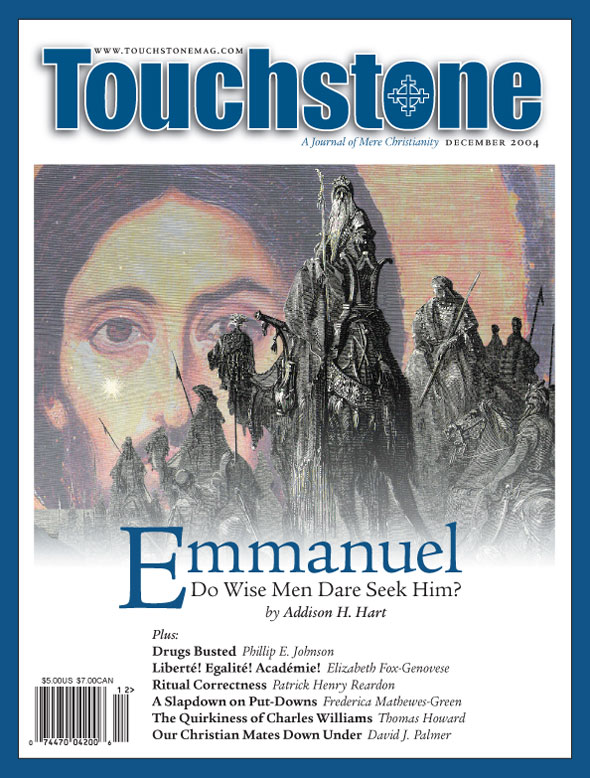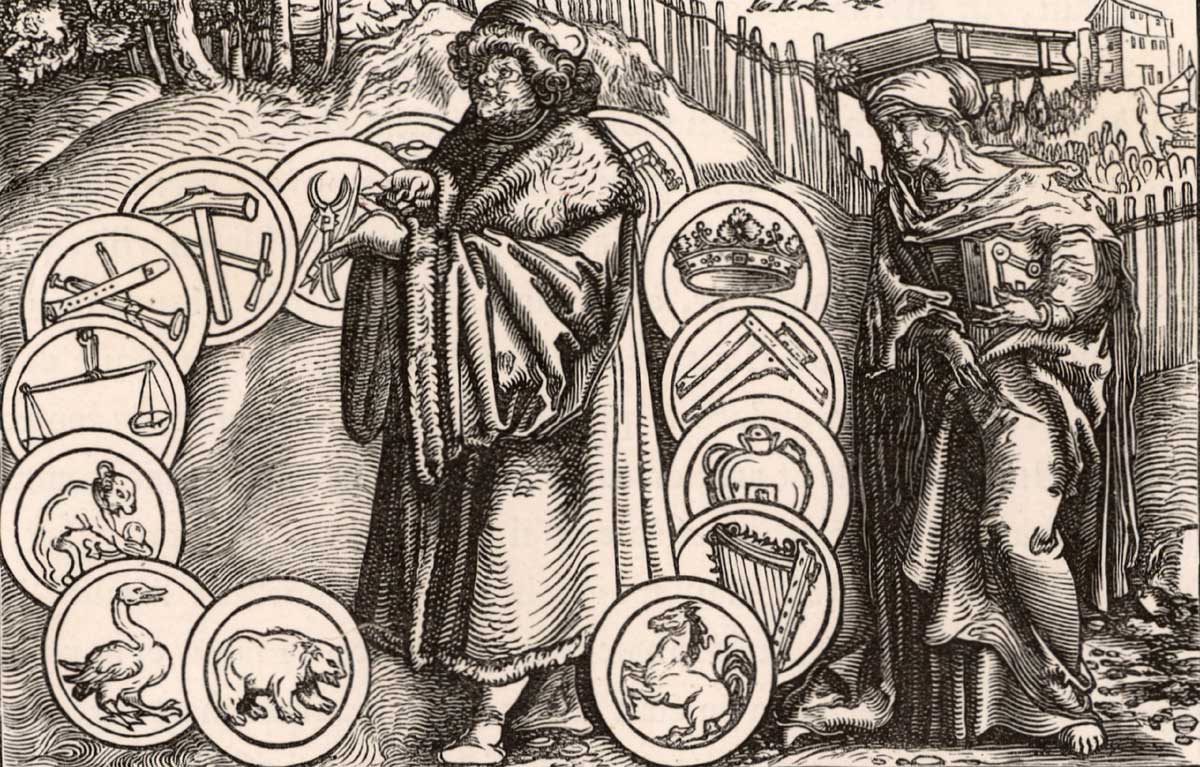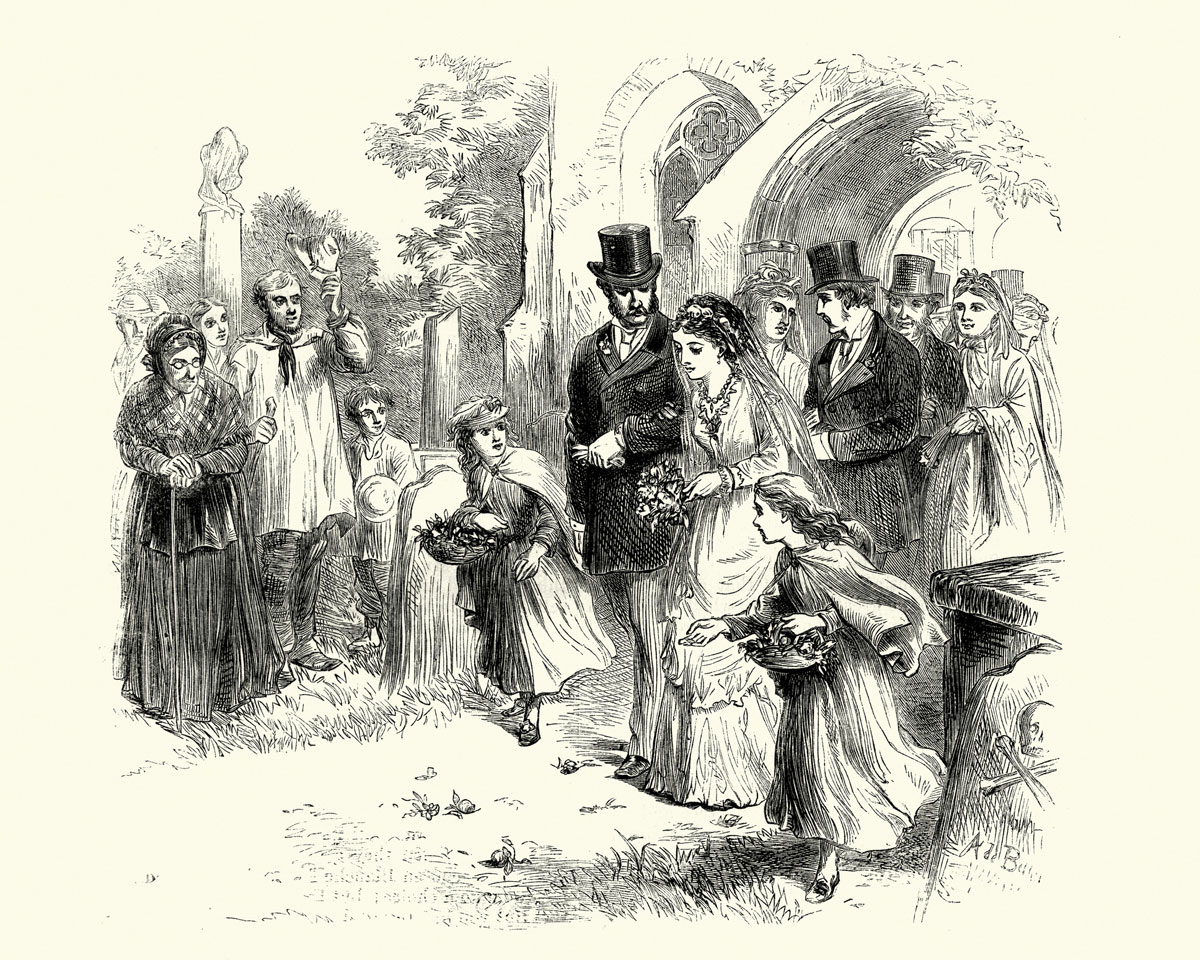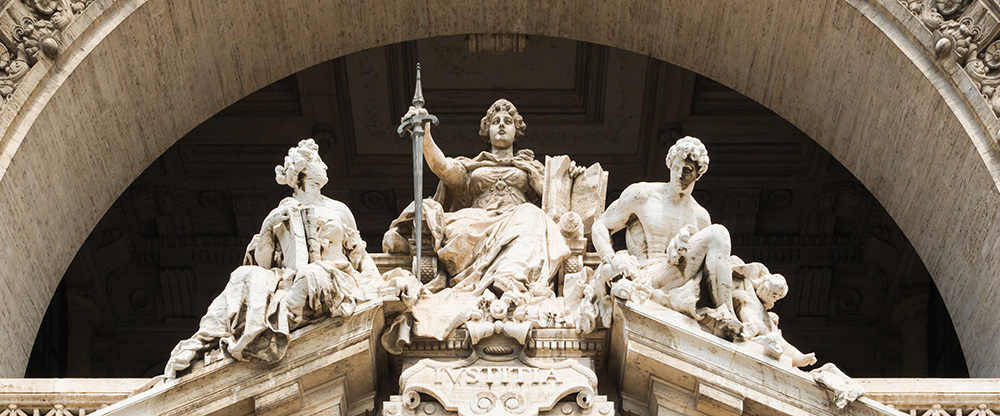The Divine Divider
Judgment & the Meaning of “Emmanuel” in Matthew’s Gospel
by Addison H. Hart
When, during the seasons of Advent and Christmas, we joyfully sing carols about the birth of “Emmanuel,” we should do so with a certain amount of trepidation. Along with the message of the comfort of his coming, we would do well to hold in mind the complementary truth of the crisis it brings.
Only in Matthew’s Gospel do we find Jesus identified with Isaiah’s prophecy of the one to be called “Emmanuel,” “God with us” (Is. 7:14; Matt. 1:23). The long-awaited Messiah would come from the royal House of David, and through him God would be present in a way hitherto unknown in the history of his covenant people. But Jesus Christ is not merely “the Son of David,” he is “God with us.”
Matthew wants his readers to grasp that in Emmanuel, “God with us,” something has occurred that is so astounding, so new, so infinitely rewarding or damning potentially for each individual, that we who profess Christ are to be judged in the light shed by this stunning revelation.
Emmanuel’s Judgment
He who is called Emmanuel is God, utterly transcendent, thus possessing the power to be present with us throughout time; he is with us, immanent, thus powerfully present in our midst every day.
This, then, is one of the real and weighty implications of “Emmanuel”: because Jesus is “God with us,” how one responds directly to Jesus Christ is of crucial and eternal importance. Judgment is implicit for one who really encounters Christ. In relation to him, each human life is potentially unfolding or withering throughout the time allotted its earthly existence, until that “day” when each soul’s implicit lifelong judgment is revealed explicitly before the throne of the Son of Man.
Judgment in Matthew is both implicit and explicit. In the story of the betrayal, trial, and death of Jesus, Matthew shows the judgments implicit in three very different individuals’ encounters with Jesus. He directs essentially the same pointed statement to each of the three, which puts each of them in the situation of pronouncing judgment upon himself, though they do not seem to realize it. In all three instances, Christ is seen to be the true Judge, hidden though this fact is beneath his weakness and suffering.
The first of the three encounters is that of Jesus with Judas at the Last Supper. Immediately before the institution of the Eucharist, Jesus foretells that one of the twelve disciples will betray him. The disciples, understandably disturbed by this, ask him one after another, “Is it I?” When Judas asks the question, the Lord responds: “You have said so” (26:20–25).
The second encounter is that with the High Priest, Caiaphas (26:57–66). Exasperated by the silence of Jesus before the Sanhedrin, Caiaphas demands of him, “I adjure you by the living God, tell us if you are the Christ, the Son of God.” Jesus’ reply is identical to the one given earlier to Judas: “You have said so.” He continues: “But I tell you, hereafter you will see the Son of Man seated at the right hand of Power, and coming on the clouds of heaven” (26:63–64). In other words, one day the tables will be turned, and Caiaphas will find himself before the true Judge—the very One he now presumes to judge.
The last of the three encounters is that with Pilate. “Are you the King of the Jews?” he asks. Jesus answers: “You have said so” (27:11).
Each encounter recalls the reader to something Jesus said earlier in the Gospel: “I tell you, on the day of judgment men will render account for every careless word they utter; for by your words you will be justified, and by your words you will be condemned” (12:36–37). When Jesus says, “You have said so,” he is saying, in effect, “What you have said may very well condemn you on the day of judgment.”
Falsified & Fruitless
The one instance of explicit judgment in Matthew is connected to a theme that runs through the course of his Gospel and is symbolized in a particularly severe and sobering prophetic sign. The theme is the judgment of corrupt or falsified (though not false) religion. The prophetic sign is a fruitless fig tree.
If in Jesus “God is with us,” we should expect that that special religion born of supernatural revelation, one that had enjoyed the benefit of a divinely ordained cultic institution and been fitted by God with unique authority for the purpose of manifesting his truth before the nations, would itself undergo a test—a crisis—when God himself showed up and took stock of it.
The Old Testament prophets had warned of divine visitation from time to time, in general terms, and of its possible consequences. With the coming of Christ, the religion of the Temple and synagogue found itself literally face-to-face with its covenant-bestowing Lord and Redeemer, come in the flesh, and the great difference between the two—the religion and the Lord—rapidly became open conflict.
Let us now look at the prophetic action involving the hapless fig tree (21:18–22). To understand it, we must recall three earlier statements in the Gospel likening false religion to a tree that bears bad fruit.
The first statement is made when Matthew introduces us to John the Baptist. When “many of the Pharisees and Sadducees” come to be baptized(!), he ferociously denounces them:
“You brood of vipers! Who warned you to flee from the wrath to come? Bear fruit that befits repentance, and do not presume to say to yourselves, ‘We have Abraham as our father’; for I tell you, God is able from these stones to raise up children to Abraham. Even now the ax is laid to the root of the trees; every tree therefore that does not bear good fruit is cut down and thrown into the fire.” (3:7–10)
The second is found near the conclusion of the Sermon on the Mount. Jesus is speaking about “false prophets, who come to you in sheep’s clothing but inwardly are ravenous wolves” (7:15), and warns of false religion:
“You will know them by their fruits. Are grapes gathered from thorns, or figs from thistles? So, every sound tree bears good fruit, but the bad tree bears evil fruit. A sound tree cannot bear evil fruit, nor can a bad tree bear good fruit. Every tree that does not bear good fruit is cut down and thrown into the fire. Thus you will know them by their fruits.” (7:16–20)
The third occurs during one of the most heated conflicts between Jesus and the Pharisees. They accuse him of casting out demons, not by the Holy Spirit, but “by Beelzebul, the prince of demons” (12:24). Jesus makes it clear to them that such an accusation is, at least potentially, a blasphemy against the Holy Spirit. He continues with these words: “Either make the tree good, and its fruit good; or make the tree bad, and its fruit bad; for the tree is known by its fruit. You brood of vipers!” (33–34a).
More Merciful than David
These three earlier statements set us up for the explicit sign of Jesus’ cleansing of the Temple (21:12–13). With this startling prophetic action, Jesus proclaims: “It is written, ‘My house shall be called a house of prayer’; but you make it a den of robbers.” It is a clear manifestation of God’s judgment on the religion of the Temple.
The chief priests and scribes are indignant at how Jesus is being received by the children, who are crying, “Hosanna to the Son of David!” (verses 14–17, a passage most profitably read with 18:1–6 and 19:13–15 in mind). The supposed custodians of God’s Law are likewise incensed about “the wonderful things that [Jesus] did.” Verse 14 tells precisely what these wonderful things were: “And the blind and the lame came to him in the Temple, and he healed them.”
This verse, found only in Matthew, is also a prophetic sign. He who is hailed as “Son of David” now overrides David himself, showing himself merciful where David most emphatically was not. The verse contrasts sharply with the words found in the Septuagint’s rendering of 2 Samuel 5:8: “Therefore it is said, ‘the blind and the lame shall not come into the House of the Lord’”—words that are directly related to David’s “hatred of soul” for the blind and lame, which he expressed during his conquering of Jerusalem a millennium before Christ’s appearing. Jesus reveals his grace and power to the blind, the lame, and the children—those who represent “the least of these my brethren” (25:40). The religious authorities, in contrast, despise him for it.
Then comes the fig tree incident (21:18–22), the sign of decisive judgment given to the disciples:
In the morning, as he was returning to the city, he was hungry. And seeing one fig tree by the wayside he went to it, and found nothing on it but leaves only. And he said to it, “May no fruit ever come from you again!” And the fig tree withered at once. When the disciples saw it they marveled, saying, “How did the fig tree wither at once?” And Jesus answered them, “Truly, I say to you, if you have faith and never doubt, you will not only do what has been done to the fig tree, but even if you say to this mountain, ‘Be taken up and cast into the sea,’ it will be done. And whatever you ask in prayer, you will receive, if you have faith.”
In Greek, the fig tree is clearly designated by Matthew as “ one fig tree” (it is unfortunate that translations invariably render this “ a fig tree”). He is given to “doubling” in some of his Gospel’s accounts of events: two demoniacs in 8:28–34, not one as in Mark and Luke; two blind men each in both 9:27–31 and 20:29–34; and two donkeys for Jesus to ride in 21:1–7. (This literary device may signify the inclusion of both Jew and Gentile into the Kingdom, but this is only a conjecture; see Eph. 2:11–22.) It seems noteworthy, then, that he appears to emphasize that there was only “ one fig tree.”
Tree & Temple
The fact that Jesus responds to his disciples’ astonished query with a teaching on prayer picks up on what he had decried only a few short verses earlier as notably lacking in the Temple: “It is written, ‘My house shall be called a house of prayer’; but you make it a den of robbers.”
The fig tree is fruitless; so are the Temple and the religion Jesus confronts there. “One” fig tree is judged with a dreadful malediction for its fruitlessness; one form of revealed religion will similarly meet with judgment for its own barrenness: “Behold, your house is forsaken and desolate. For I tell you, you will not see me again, until you say, ‘Blessed is he who comes in the name of the Lord’” (23:38–39). The One who forsakes the Temple is “God with us.”
In the place of this forsaken and desolate “house of prayer,” the Lord begins to build his disciples into a new house of prayer: “Whatever you ask in prayer, you will receive, if you have faith.” Or, to shift to the other metaphor at work here, in place of “one” barren fig tree, Christ plants another, which, through faith, is intended to bear fruit. (That there is another “fig tree” may be inferred from 24:32–33.)
The image of the fruitless fig tree is also complemented by the parable of the evil vinedressers in 21:33–46, where the Lord’s desire for a “fruit-bearing nation” is stressed as the reason for God’s new action in Christ: “Therefore I say to you, the Kingdom of God will be taken from you and given to a nation bearing the fruits of it” (21:43).
If any ambiguity regarding the nature of the sign of the fig tree and the judgment it portended lingered in the disciples’ minds afterward, it must have been dispelled when he said, in response to their excited wonder before the magnificent buildings of the Temple: “You see all these, do you not? Truly, I say to you, there will not be left here one stone upon another, that will not be thrown down” (24:2). The judgment apparently begins at the very moment of Jesus’ death on the cross: “And behold, the curtain of the Temple was torn in two, from top to bottom” (27:51).
The fig tree stands as a sign of judgment on corrupt, barren, falsified religion. There is an implicit warning for Christ’s Church in it, however, which should never be forgotten or overlooked. It is not unlike the stern warnings pronounced on erring churches by Christ in the second and third chapters of the Book of Revelation. For Christ’s followers to avoid a similar judgment, a condemnation for fruitless and hypocritical religion, they must take careful heed of the examples of the Pharisees and Sadducees (16:6).
The Church’s Warning
With judgment we see two irreconcilable things, hitherto mingled, separated. Two ultimate possibilities reach their appointed and necessary divergence. “Enter by the narrow gate; for the gate is wide and the way is easy, that leads to destruction, and those who enter by it are many. For the gate is narrow and the way is hard, that leads to life, and those who find it are few” (7:13–14).
Repeatedly the Lord reminds his disciples through his parables that there will be a separation, a judgment, and that it will in fact begin, in the words of 1 Peter 4:17, at the Household of God. On that day those who have heard the initial invitation to enter the Kingdom of Heaven will be divided. “Not every one who says to me, ‘Lord, Lord,’ shall enter the Kingdom of Heaven, but he who does the will of my Father who is in Heaven” (Matt. 7:21). The final division will be determined by whether or not one has built his life on “rock” or on “sand.” In other words, whether or not one has both heard and done (not just heard) “these words of mine” (7:24–27).
So it is that the parables realistically present the Kingdom as it is in this age as a mixed bag. It contains wheat and tares (13:24–30, 36–43), good and bad fish (13:47–50), obedient and wicked servants (24:45–51), wise and foolish virgins (25:1–13), and productive and slothful stewards of their Master’s property (25:14–30). All these are destined for separation come the Day of Judgment. Indeed, the culminating parable of Matthew, the one to which all the others lead up, is that of the Great Judgment in 25:31–46. The two categories to be separated there forever are likened to sheep and goats.
The parables depict a future division into two categories of persons, one under benediction and the other under malediction, among those who share something of the Kingdom’s presence here and now. That both good and bad are, before the end of the age, found in the Kingdom is a reminder of God’s own comprehensive generosity. The disciples are pointedly told to emulate their heavenly Father, who “makes his sun rise on the evil and on the good, and sends rain on the just and on the unjust” (5:43–48). Jesus, “God with us,” embodies this indiscriminate bestowal of divine favor during his ministry: The Pharisees “said to his disciples, ‘Why does your teacher eat with tax collectors and sinners?’” (9:11).
Sheep from Goats
Yet, although God invites all sorts into the Kingdom, the Great Judgment will divide them. The parable of 25:31–46 is the final parabolic icon of this in Matthew’s Gospel. The One on the throne is the Son of Man, a title that corresponds to the name “Emmanuel.” Before him are “gathered all the nations.” What is going to happen, what the Son of Man will do, is “separate them one from another as a shepherd separates the sheep from the goats.”
By “nations” ( ethne) is understood those taken out of “all nations”: those answering the summons to become “disciples” through the proclamation and teaching of the apostles (28:19). Wheat and tares, good and bad fish, obedient and wicked servants, wise and foolish virgins, and productive and lazy stewards are all about to be divided one from another. They will be separated on the basis of what, ultimately, constitutes the line of difference between good and bad religion. And that line is itself drawn by the Son of Man, who here spells out definitively what it means to embrace the truth that “God is with us.”
Matthew is not presenting here a picture of the judgment of unbelievers. That future event is merely something to be expected, not a necessary point to be driven home to his disciples. Nothing in the immediate context could lead us to the evasive conclusion that the judgment upon the “goats” is a judgment upon those outside the present visible Kingdom community. What he is depicting is something far more staggering and crucial for his followers: the terms of future judgment for those who claim to know, follow, and love Emmanuel. It means that Christ’s disciples must really grasp in this world the incarnational significance of “Emmanuel” and convert that into living practice.
Throughout the Sermon on the Mount, Jesus makes explicit the grounds for this judgment. Good religion was elucidated: It is in essence a righteousness that exceeds that of the scribes and Pharisees, far removed from their sort of petty, man-made, ossified, and often inhumane legal externalisms (5:19–20). The model for this true righteousness is the perfect charity of the Father (5:43–48), made incarnate, visible, and imitable in the Son.
In the parable, the terms are stated with a clarity that should, at least from time to time, send a shock of conviction and contrition through professing believers as they read it: “Truly, I say to you, as you did it to one of the least of these my brethren, you did it to me. . . . Truly, I say to you, as you did it not to the least of these, you did it not to me” (25:40, 46). What lies behind these words is the full force of the meaning of “God with us.” The realization of this truth must impel his disciples to seek to become “sons of [their] heavenly Father,” loving neighbor and enemy alike, leaving judgment in the hands of God, so that they might become “perfect [in charity], as [their] heavenly Father is perfect.”
In the brilliance of such an altered vision of humanity—a humanity joined eternally to the Lord who made it in his own image, a humanity thereby revealed to be of infinite worth, a humanity for which he died and which in his own person he raised from the bonds of death—there can be no disdain or disregard for any human being, and especially not for “the least,” who are thus in need of our particular care and protection (the child, the blind, the lame, the hungry, the thirsty, the sick, the suffering, the prisoner, the stranger . . . and, I dare add, the unborn).
Matthew’s Invitation
For Matthew, judgment begins with the Household of God. It is not based merely on a set of moral rules but on revealed “righteousness,” and certain questions must inevitably arise for the professing Christian as a consequence: Who is Jesus Christ, “Emmanuel,” and what does this mean for the way I live my life now? In following him, have I avoided bad religion, that is, “the leaven of the Pharisees and Sadducees”? Have I sought to live according to the ideal of perfection in love, especially as it pertains to “the least,” which is the very character of the Father, and made visible in Christ?
None of this is to be taken as an invitation to scrupulosity or self-nagging or despair. Matthew is not presenting Christ as a sort of replacement of one form of “Pharisaism” with another. This is not just another version of religious moralism or externalism or formalism, none of which make allowance for the real struggles, challenges, and occasional failures inherent to Christian discipleship.
Rather, it is an invitation to know and respond to Christ in such a way that one is truly transformed interiorly with a transfiguration that manifests itself in genuine, practical, unsentimental love of God and neighbor. God is with us: Christ is with us all our days until the completion of this age. Because he is with us, we can always change; we can fall, but we do not have to stay down. We can always get back up and start anew.
Addison H. Hart is retired from active ministry as parish priest and university chaplain. He is the author of Knowing Darkness: On Skepticism, Melancholy, Friendship, and God and The Yoke of Jesus: A School for the Soul in Solitude (both from Eerdmans). His forthcoming book is a study of the Sermon on the Mount. He lives and writes in Norheimsund, Norway.
subscription options
Order
Print/Online Subscription

Get six issues (one year) of Touchstone PLUS full online access including pdf downloads for only $39.95. That's only $3.34 per month!
Order
Online Only
Subscription

Get a one-year full-access subscription to the Touchstone online archives for only $19.95. That's only $1.66 per month!
bulk subscriptions
Order Touchstone subscriptions in bulk and save $10 per sub! Each subscription includes 6 issues of Touchstone plus full online access to touchstonemag.com—including archives, videos, and pdf downloads of recent issues for only $29.95 each! Great for churches or study groups.
Transactions will be processed on a secure server.
more from the online archives
calling all readers
Please Donate
"There are magazines worth reading but few worth saving . . . Touchstone is just such a magazine."
—Alice von Hildebrand
"Here we do not concede one square millimeter of territory to falsehood, folly, contemporary sentimentality, or fashion. We speak the truth, and let God be our judge. . . . Touchstone is the one committedly Christian conservative journal."
—Anthony Esolen, Touchstone senior editor









